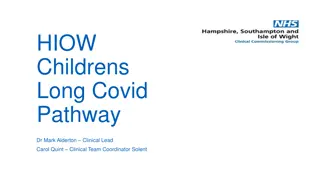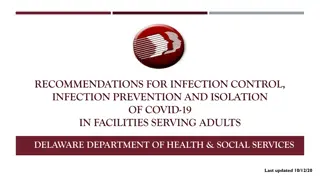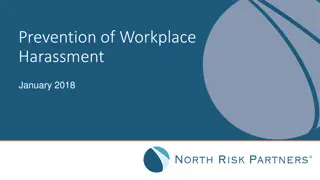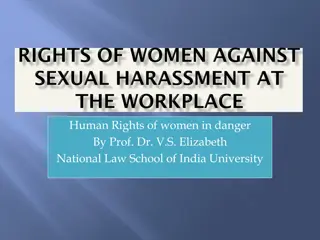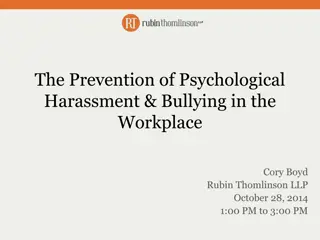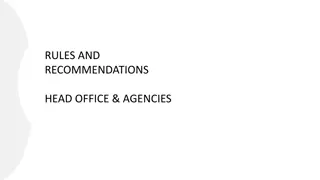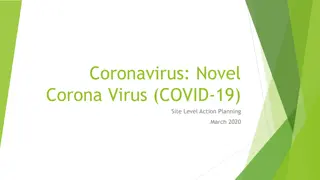Workplace Guidelines for COVID-19 Prevention
Learn about workplace guidelines for preventing the spread of COVID-19, including how the virus is transmitted, company responsibilities such as maintaining cleanliness, promoting respiratory etiquette and hand hygiene, and emphasizing the importance of sick employees staying home. Follow these guidelines to create a safe work environment during the pandemic.
Download Presentation

Please find below an Image/Link to download the presentation.
The content on the website is provided AS IS for your information and personal use only. It may not be sold, licensed, or shared on other websites without obtaining consent from the author.If you encounter any issues during the download, it is possible that the publisher has removed the file from their server.
You are allowed to download the files provided on this website for personal or commercial use, subject to the condition that they are used lawfully. All files are the property of their respective owners.
The content on the website is provided AS IS for your information and personal use only. It may not be sold, licensed, or shared on other websites without obtaining consent from the author.
E N D
Presentation Transcript
Interim Workplace Guidelines COVID-19
PAHO/WHO HOW IT IS TRANSMITTED HOW IT IS TRANSMITTED Through close contact with an infected person or by an infected person coughing or sneezing By touching contaminated objects or surfaces and then touching your mouth, nose, eyes
PAHO/WHO COMPANY RESPONSIBILITY 1.Make sure workplaces are clean and hygienic o Surfaces (e.g. desks and tables) and objects (e.g. telephones, keyboards) need to be wiped with disinfectant regularly
PAHO/WHO COMPANY RESPONSIBILITY 2. 2. Promote respiratory etiquette and hand hygiene by all Promote respiratory etiquette and hand hygiene by all employees, contractors and customers: employees, contractors and customers: o Place posters that encourage cough and sneeze etiquette, and hand hygiene at the entrance to your workplace and in other workplace areas where they are likely to be seen. o Create digital versions of posters and share on intranet and use as screen savers o Put sanitizing hand rub dispensers in prominent places around the workplace. Make sure these dispensers are regularly refilled
PAHO/WHO COMPANY RESPONSIBILITY 2. 2. Promote respiratory etiquette and hand hygiene by all Promote respiratory etiquette and hand hygiene by all employees, contractors and customers cont d: employees, contractors and customers cont d: o Ensure staff, contractors and customers have access to places to wash their hands with soap and water o Provide face masks (Ordinary surgical face masks rather than N95 face masks) and / or paper tissues for those who develop a runny nose or cough at work; closed bins for hygienically disposing of them o Implement initiatives such as offering guidance from occupational health and safety officers, briefing at meetings
PAHO/WHO COMPANY RESPONSIBILITY 3. 3. Emphasize that sick employees stay at home Emphasize that sick employees stay at home o Brief your employees, contractors and customers that if COVID-19 starts spreading in your community anyone with even a mild cough or low-grade fever (37.3 C or more) needs to stay at home. o They should also stay home (or work from home) if they have had to take simple medications, such as paracetamol/acetaminophen, ibuprofen or aspirin, which may mask symptoms of infection o Employees who appear to have acute respiratory illness symptoms (i.e. cough, shortness of breath) upon arrival to work or become sick during the day should be separated from other employees and be sent home immediately.
PAHO/WHO COMPANY RESPONSIBILITY 2. 2. Provide travel guidelines Provide travel guidelines Before Travel Before Travel o Make sure employees have the latest information on areas where there is high transmission of COVID-19 - https://www.who.int/emergencies/diseases/novel- coronavirus-2019/situation-reports/ o Avoid sending employees who may be at higher risk of serious illness (e.g. older employees and those with medical conditions such as diabetes, heart and lung disease) to areas where COVID-19 is spreading. o Make sure all persons travelling to locations reporting COVID-19 are briefed by a qualified professional o To facilitate regular hand-washing, consider issuing employees who are about to travel, small bottles (under 100 CL) of alcohol-based hand sanitizer.
PAHO/WHO COMPANY RESPONSIBILITY 2. 2. Provide travel guidelines Provide travel guidelines While Travelling While Travelling o Encourage employees to wash their hands regularly and stay at least one meter away from people who are coughing or sneezing o Ensure employees know what to do and who to contact if they feel ill while traveling o Ensure that your employees comply with local restrictions on travel, movement or large gatherings in countries where they are traveling
PAHO/WHO COMPANY RESPONSIBILITY 2. 2. Provide travel guidelines Provide travel guidelines On Return from Travel On Return from Travel o Employees who have returned from an area where COVID-19 is spreading should monitor themselves for symptoms for 14 days and take their temperature twice a day. o If employees develop even a mild cough or low grade fever (i.e. a temperature of 37.3 C or more) advise them to stay at home and self-isolate. This means avoiding close contact (one meter or nearer) with other people, including family members. They should also telephone their healthcare provider or the local public health department, giving them details of their recent travel and symptoms, immediately.
PAHO/WHO COMPANY RESPONSIBILITY 1. 1. Personnel Policy Personnel Policy Recomendations Recomendations o Ensure that your sick leave policies are flexible and consistent with public health guidance and that employees are aware of these policies o Talk with companies that provide your business with contract or temporary employees about the importance of sick employees staying home and encourage them to develop non-punitive leave policies. o Employers should maintain flexible policies that permit employees to stay home to care for a sick family member. Employers should be aware that more employees may need to stay at home to care for sick children or other sick family members than is usual. o If an employee is confirmed to have COVID-19, employers should inform fellow employees of their possible exposure to COVID-19 in the workplace but maintain confidentiality
PAHO/WHO EMPLOYEE RESPONSIBILITY 1. 1. Recognize the symptoms Recognize the symptoms o Common Symptoms: Runny nose; Cough; Sore throat o Severe Cases: High fever; Pneumonia; severe respiratory disease Symptoms may appear 1 to 12 days following exposure to the virus
PAHO/WHO EMPLOYEE RESPONSIBILITY 2. 2. Prepare Prepare o Make sure to obtain all information from a reliable source: www.health.gov.tt; www.paho.org; www.who.int o Wash hands regularly with soap and water or use an alcohol-based gel o Always cover their mouth with the inside of their elbow when they cough or sneeze, or use a tissue and dispose of it immediately and wash their hands
PAHO/WHO EMPLOYEE RESPONSIBILITY 3. 3. Act Act o Stay at home if they have symptoms of acute respiratory illness and not come to work until they are free of fever, signs of a fever, and any other symptoms for at least 24 hours, without the use of fever-reducing or other symptom- altering medicines (e.g. cough suppressants) o Avoid sharing cups, plates or other personal items and follow the organizations guidelines for disinfecting all surfaces that are touched frequently o Seek medical attention immediately if they have travelled to areas where COVID-19 is circulating or have been in contact with someone who has it and they experience fever, cough, or difficulty breathing. They should not self medicate.
PAHO/WHO EMPLOYEE RESPONSIBILITY Cont d 3. 3. Act Act o Avoid close contact with people who have flu-like symptoms o Avoid touching their eyes, nose or mouth with unwashed hands o Notify their supervisor If they are well, but have a sick family member, and refer to a health professional to find out how to conduct a risk assessment of their potential exposure
PAHO/WHO PLAN TO PROTECT YOUR BUSINESS Some Key Objectives Some Key Objectives 1. Reduce transmission among staff 2. Protect people who are at higher risk for adverse health complications 3. Prepare business for COVID-19
PAHO/WHO PLAN TO PROTECT YOUR BUSINESS 1. Reduce transmission among staff o The plan should cover putting the ill person in a designated room or area where they are isolated from others in the workplace, limiting the number of people who have contact with the sick person and contacting the local health authorities. 2. Protect people who are at higher risk for adverse health complications o Consider how to identify persons who may be at risk, and support them, without inviting stigma and discrimination into your workplace. This could include persons who have recently travelled to an area reporting cases, or other personnel who have conditions that put them at higher risk of serious illness (e.g. diabetes, heart and lung disease, older age). . Some of the key considerations when making decisions on appropriate responses are:
PAHO/WHO PLAN TO PROTECT YOUR BUSINESS 3. 3. Prepare business for COVID Prepare business for COVID- -19 19 o Develop a contingency and business continuity plan o Employers with more than one business location are encouraged to provide local managers with the authority to take appropriate actions outlined in their plan based on the condition in each locality o Promote regular teleworking across your organization. If there is an outbreak of COVID-19 in your community the health authorities may advise people to avoid public transport and crowded places. Teleworking will help your business keep operating while your employees stay safe.
RESOURCES RESOURCES Register Here: https://bit.ly/2TrFxXL For daily updates and everything you need to know about COVID-19 THANK YOU!
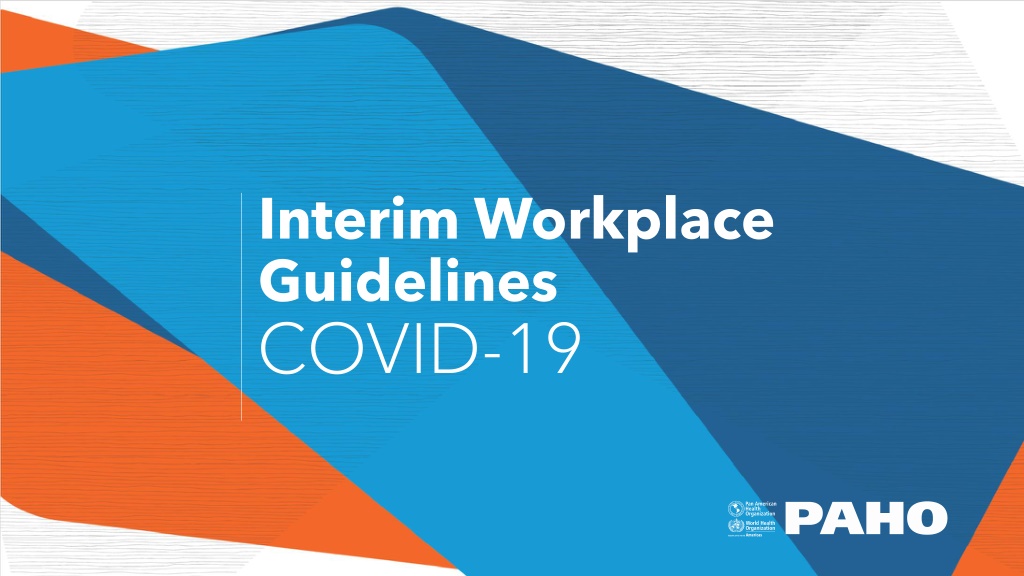






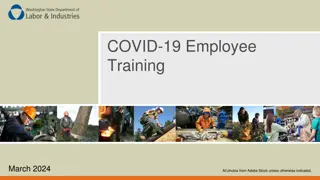


![Workplace Violence Prevention Plan in [District]: Definitions, Elements, and Implementation](/thumb/117038/workplace-violence-prevention-plan-in-district-definitions-elements-and-implementation.jpg)




